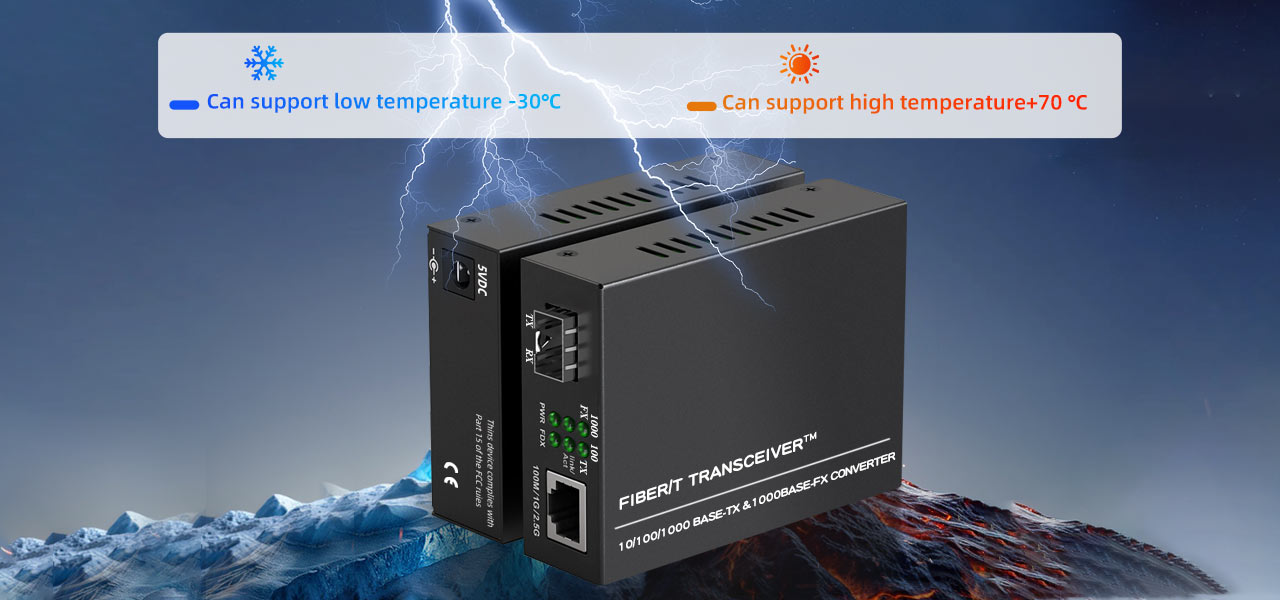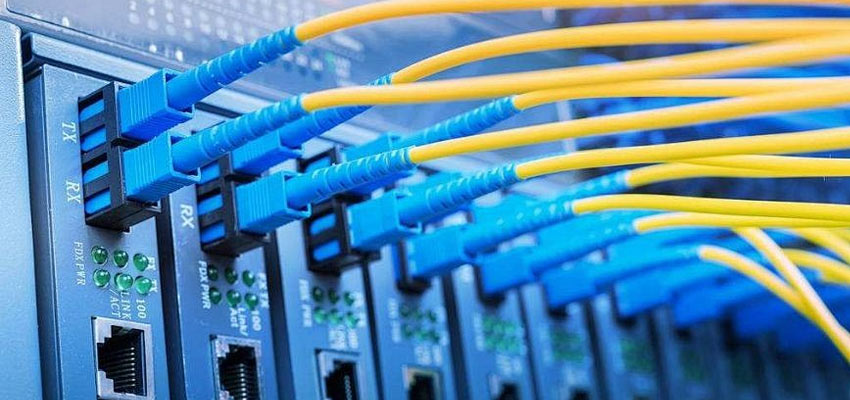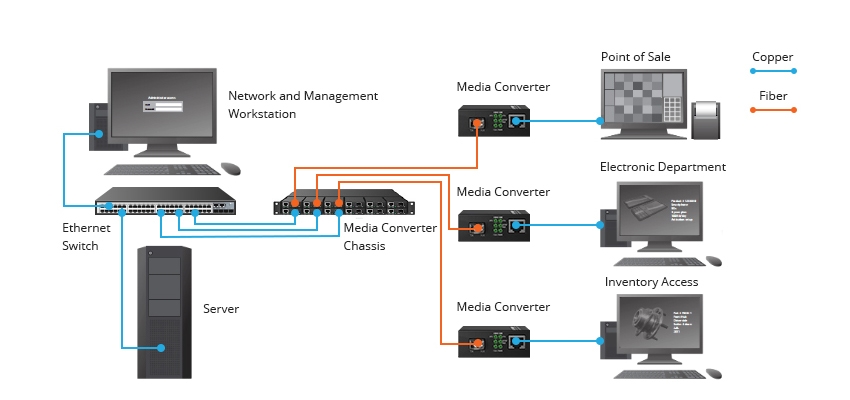Fiber Media Converters: What They Are and How to Choose the Right One

In today’s networking world, fiber media converters are essential to allowing communication across different networks (media). As networks begin to grow and evolve, the need to bridge from one transmission media to another, such as copper Ethernet cables to fiber optic cables, became essential to the infrastructure. Fiber media converters are the devices we will use to convert signals from one media type to another—for example, allowing fiber optic networks to easily integrate with copper infrastructure.
At the most basic level, fiber media converters convert electrical signals transmitted over copper cables and switch the signal to optical signals suited for fiber optic cable, and vice versa. The conversion is essential because copper cabling typically maxes out at about 100 meters and does not provide network reach to extend beyond this distance. Fiber optic cable, however, can transport data distances over kilometers with little-to-no signal loss. Therefore, fiber media converters are commonly used for long-distance communication networks, enterprise-type networks, and data centers.
Fiber media converters also extend versatility by supporting both single-mode and multimode fiber, allowing you to design your network based on performance or distance needs. Additionally, it allows legacy systems to be modified to connect to newer systems that use fiber optic connections.
It is important for both IT professionals and network administrators to know exactly what a fiber media converter is and how to select the fiber media converter based on the speed of the network, media type of the network, and application need of the organization. This article will explore what fiber media converters are, as well as aid you in deciding which type of fiber media converter is best for your environment.
What Are Fiber Media Converters?
Definition and Basic Function
Fiber media converters are networking devices that convert signals from one type of media to another, facilitating the communication over a range of network types. Fiber media converters, at their basic function, take signals in the electrical domain from a copper Ethernet cable and convert it into a signal suitable for optical transmission through fibers, and in the reverse, optic to electric conversion. Fiber media converters permit extension to the typical copper cable distance limitation of 100m by utilizing the long-distance capabilities of fiber optics.
More typical media conversions are: copper Ethernet to fiber optic, multimode fiber to single-mode fiber, and even fiber to fiber to wavelength change. For example, a typical media converter connects to a standard copper-based LAN while the other provides a connection to a fiber optic backbone to increase the amount of data traveling over distance. It is critical for enterprises to convert legacy systems to fiber optic to allow their programs to work or provide greater distance to extend their networks without unrelated costs to replace an entire system.
Fiber media converters act as a bridge for a media type so that the media type can meet and still facilitate the functions of a signal. Fiber media converters are considered essential to modern networks, mostly because they provide scalable solutions to network design with flexibility.
 Types of Fiber Media Converters
Types of Fiber Media Converters
The types of fiber media converters can be broken down into some categories of use in networks:
• Copper to fiber media converters convert signals received as copper/Ethernet and send them as fiber optic outputs.
• Fiber to fiber media converters convert signals received as fiber optic signals but can change bandwidth capability, such as convert multimode to single-mode capabilities.
• Power over Ethernet media converters (PoE) combine the conversion capabilities with the ability to provide power over Ethernet.
• Managed media converters come with some enhanced capabilities including diagnostics and configuration from remote locations. Unmanaged media converters do not allow any remote programming capability. Unmanaged media converters allow interconnectivity with plug-and-play convenience.
Key Features and Technical Specifications
Supported Speeds and Protocols
Fiber media converters support a wide range of network speeds, including 10/100 Mbps, 1 Gbps (Gigabit Ethernet), and up to 10 Gbps. These media converters support Ethernet standards such as Fast Ethernet, Gigabit Ethernet, and 10G Ethernet, providing compatibility with many different types of enterprise-level networks. Choosing a media converter at an appropriate supported speed is critical for optimizing network performance and preparing for future network functions.
Fiber Types and Connector Interfaces
Most fiber media converters support single-mode and multimode fiber types. Single-mode fiber media converters are designed for long-distance transmissions; multimode fiber media converters are for shorter range. There are many different types of connector types including: SC, LC, and ST, with LC being the most common for high-density environments such as data centers. Rack media converters allow multiple media converters to be managed from one location in a centralized rack mount installation.
Power Supply and PoE Support
Media converters can be powered by AC or DC inputs and/or other flexibly powered options. PoE media converters provide both data and power over one cable, supporting remote devices such as IP cameras and wireless access points, lowering complexity and installation costs.
Fiber Media Converter vs Ethernet Extender: Detailed Comparison
Ethernet extenders use existing copper to extend the Ethernet signal over existing wires, using DSL technology, but do not convert media types. Fiber media converters convert signals from copper to fiber and fiber to copper, allowing for longer distances and higher speeds.
| Feature | Fiber Media Converter | Ethernet Extender |
|---|---|---|
| Media Conversion | Yes (fiber to copper/fiber) | No (Ethernet to DSL over copper) |
| Max Transmission Distance | Up to 160 km (fiber dependent) | Up to 20 km (using copper pairs) |
| Speed Support | 10/100/1000 Mbps, 10 Gbps | Typically 10/100/1000 Mbps |
| Installation Complexity | Moderate | Lower (uses existing copper) |
| Typical Use Cases | Network upgrades, fiber extension | Using existing copper wiring |
Fiber media converters suit high-speed, long-reach fiber network extensions, while Ethernet extenders are budget-friendly solutions for reusing existing copper cables to moderate distances.
Common Applications and Use Cases
Fiber media converters can be found in enterprise networks, campus LANs, data center interconnects, factory settings with electromagnetic interference (EMI), and PoE system extensions that include cameras. StarTech and TP-Link are reliable brands that have good gigabit fiber media converters. Industrial media converters are designed to operate in harsh conditions, providing for consistent communication in environments with electrical noise and heat.
Installation and Configuration Tips
There are both plug-and-play media converters as well as managed media converters. Typically, plug-and-play converters present very little configuration to be set up. Managed media converters provide configuration settings that allow for additional tuning and monitoring of performance. Many auto-negotiate and duplex settings work automatically, but some situations may require manual tuning. For troubleshooting, start with link lights and clean fibers. Confirm that the proper cable is being utilized.
 Frequently Asked Questions
Frequently Asked Questions
What is a fiber media converter?
A fiber media converter is a tool that uses the different signal characteristics of copper Ethernet cables to convert into fiber optic cables, offering users extensions of their networks while providing different media types.
What is the difference between a fiber media converter and an Ethernet extender?
Media converters utilize a separate capability between types of media (copper to fiber) while Ethernet extenders improve your Ethernet signal over the copper wiring, without any media conversion.
Can I use fiber media converters for a PoE device?
Yes, PoE media converters provide both data and power through a single fiber link to power remote devices such as IP cameras.
What type of fiber and connectors will media converters work with?
Media converters will work with single-mode fiber and multimode fiber. Some examples are SC, LC, and ST.
How far do fiber media converters extend my network?
Single-mode fiber converters can extend your network 160 km and multimode fiber converters typically extend your network up to 2 km.
Conclusion
Fiber media converters are a vital component of modern-day networks offering users flexibility in terms of media conversion and network extension. Finding the right one based on your application, media type, and speed will allow your media converter to perform as it should while ensuring scalability for your current and future needs! Knowing this will help make your network infrastructures future-proof!

 Types of Fiber Media Converters
Types of Fiber Media Converters Frequently Asked Questions
Frequently Asked Questions